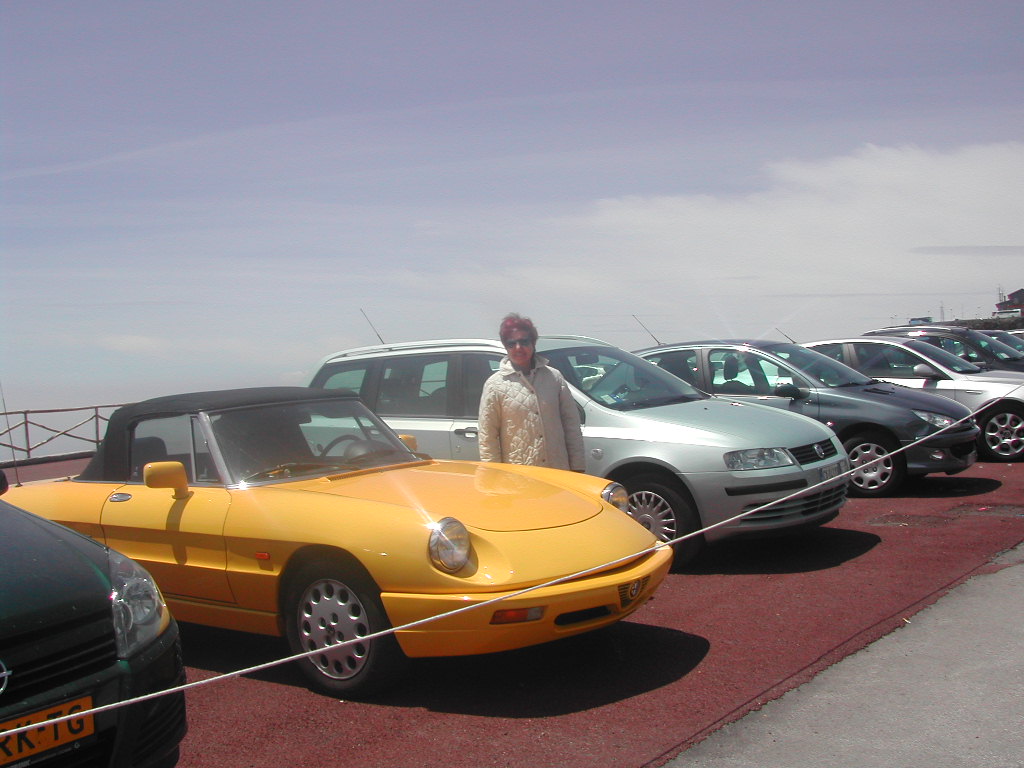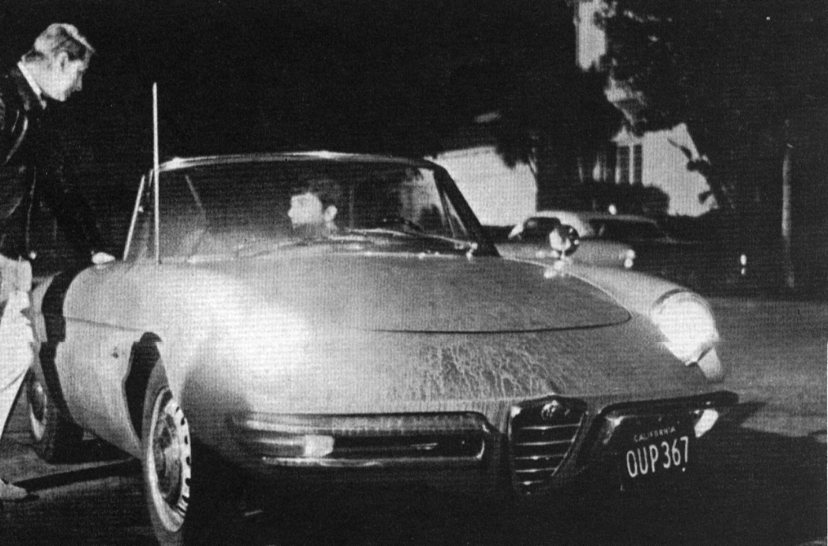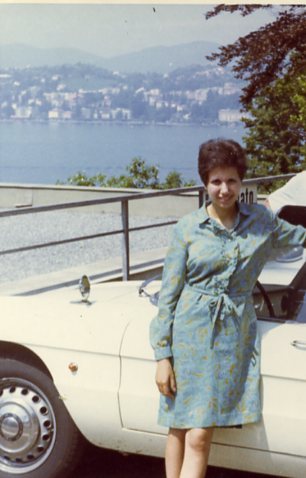
|  The History of Alfa Romeo
 (by Elvira Ruocco)
Article 4a
 MS. RUOCCO PORTRAYED ON THE ETNA VOLCANO
 BESIDE A... "SUNNY" SPECIMEN
|
UNDER THE SUN SHE'S ALWAYS THE MOST BEAUTIFUL
In her first version, the ‚ÄúDuetto‚ÄĚ, the Alfa Romeo spider, whose bodywork was designed by Pininfarina, later renamed ‚ÄúOsso di Seppia‚ÄĚ
i.e. ‚ÄúCuttlebone‚ÄĚ) owing to her spindle-shaped profile, was introduced during the month of March 1966 at the Geneva Car Show,
equipped with a 1,570 cm3 four-cylinder engine.
In order to give her a name, an international poll among Alfisti was announced.
Polling cards were available by the Alfa Romeo dealers, which, at the deadline of May 10th, amounted to 140,501 with 15,000
thereof coming from abroad. Each one contained a name for this gorgeous car, that at the car show had simply been exposed as
Spider 1600‚ÄĚ. Among all the proposals received, some of which authoritative as the one from Prince Bernhard of the Netherlands,
it was chosen that from Mr. Guidobaldo Trionfi from Brescia, who received the keys of the spider offered as a prize from the hands
of the President Giuseppe Luraghi.
But such a name did not come out lucky since the confectionery industry Pavesi noticed Alfa Romeo that, among their sweet products
they were marketing since some time a snack made up of biscuit and stuffing cream whose name was just Duetto.
The person then in charge of the External Relationships of Alfa Romeo, Dr. Camillo Marchetti, and Dr. Giorgio Colombo, his interface
at Pininfarina, organized a cruise on the Raffaello superliner launched at the San Marco shipyard in Trieste. The ship sailed on
May 11th and, while it was logging 27 knots on the Atlantic, passengers on the Lido deck tested, as if they were on a track, three
spiders which were addressed to a promotional exhibition of Italian products organized by Finmeccanica in New York. The ship called
at Cannes, where the Film Festival was taking place and several actors, among whom Vittorio Gassman, Rossella Falk, and the director
Renzino Avanzi, son of the baroness Maria Antonietta Avanzo (one of the first racing driver women), were attracted by such unusual “
introduction‚ÄĚ and went aboard to be photographed beside the new car.
Hence it landed in America, but it was Dustin Hoffman to make it famous in the celebrated film ‚ÄúThe Graduate‚ÄĚ.
 FROM THE FILM "THE GRADUATE" WITH DUSTIN HOFFMAN
FROM THE FILM "THE GRADUATE" WITH DUSTIN HOFFMAN
Two years later, provided with a propeller increased to 1,779 cm3, it was renamed 1750 Spider Veloce (i.e. Fast) and it was the first
car produced also following the U.S.A. market specifications, with the provision of fuel injection and prescribed lightning devices.
In 1968 appeared as well a second version with a 1,290 cm3 engine, without Plexiglas protections for headlamps and two years later the
spider bodywork was reused with the adoption of the cut-off tail. In 1971, the engine displacement was brought to 1,962 and the car took
on the denomination 2000 Spider Veloce and was always present on the American market till the end of 1994, year in which Alfa withdrew.
Among the US models, we recall the three fittings: Graduate, Quadrifoglio (i.e. Four-leaf clover), Veloce (1986-1989) and the special
CE (Commemorative Edition) version of January 1994.
In 1972 the engine displacement 1,750 disappeared, which was replaced back with a 1.6-liter one. The range was articulated in Spider
Junior 1300, Spider 1600 and Spider Veloce 2000. The 1300 version went out of production in 1981. In 1983, the car underwent a complete
restyling of bodywork and upholstery (texalfa), in the blue and beige colours and in an optional natural leather fitting.
On every versions the Plexiglas protections disappeared and an eye-catching spoiler in soft synthetic material was introduced,
but no substantial modification was brought to engines and mechanicals, always exciting due to the exceptional endowment of brilliance,
velocity, driveability and road-holding.
 DRAFT OF A DUETTO SERIES 3
DRAFT OF A DUETTO SERIES 3
In 1990, the new Spider U.S.A. Edition was presented: in the month of January at the Detroit and Los Angeles Auto Shows and, in March,
at the Geneva Car Show, in its European edition.
If the driver considers his/her car not only as a transportation mean but also as an instrument of joy, of pleasure, then, without any
doubt, the Spider in all its versions has magnified to the top, both as to performance and as to grace of shapes and comfort, an image
already unanimously recognized to every Alfa Romeo cars.
I conclude this short trip through the Duetto versions with a report concerning the chassis numberings (VINs) and colour ranges, which
follow:
SPIDER CHASSIS NUMBERINGS
Spider 1.6 duetto 1966
Avorio (Ivory)
Bianco Farina (Farina white)
Rosso Farina (Farina red)
Blu medio (Mid dark blue)
Celeste (Blue)
Verde inglese (English green)
Grigio Grafite (Graphite grey)
1750 Spider Veloce 1967-1971
Bianco Farina
Avorio
Celeste
Blu medio
Rosso Farina
Verde inglese
Grigio chiaro met.* (Metal light grey)
Nero (Black)
* dressing suppressed in July 1969
Spider 1.3 Junior 1968-1973
Bianco Farina
Avorio
Celeste
Blu medio
Rosso Farina
Verde inglese
Grigio chiaro met.*
Nero
Giallo prototipo** (Prototipe yellow)
Grigio indaco** (Indigo grey)
* dressing suppressed in July 1969
** dressing introduced in November 1972
2000 Spider Veloce 1970-1977
Rosso Italia (Italy red)
Verde inglese
Grigio indaco*
Nero
Avorio
Grigio chiaro met.
Giallo prototipo
Blu
Bianco Farina
* dressing suppressed in September 1976
Spider 1.6/2.0 1980-1983
Rosso Alfa (Alfa red)
Avorio
Nero met.
Grigio chiaro met.
Verde acqua met. (Metal water green)
Spider Q.V. 1.6/2.0 1986
Q.V.: rosso (red) and grigio met. (metal green)
2.0: bianco (white), rosso (red), nero (black) and blu medio met. (Metal mid dark blue)
Spider new generation 1990
Rosso
Grigio chiaro met.
Optional:
Hardtop in car colour
Upholstery partially in natural leather (for version 2.0 only)
Leather-covered steering wheel.
 MS. RUOCCO NEXT TO A DUETTO ON THE COMO LAKESIDE (IT WAS HER GRANDFATHER'S CAR)
MS. RUOCCO NEXT TO A DUETTO ON THE COMO LAKESIDE (IT WAS HER GRANDFATHER'S CAR)
Elvira Ruocco
Copyright Information and Credits
All the multimedia materials and the texts present in this page cannot be reproduced in any way without the explicit permit of authors and/or owners of the contents. In particular, this applies with reference to texts and pictures of Ms. Elvira Ruocco and of the Alfa Romeo Historic Archive who explicitly authorized the AlfaSport Club for publication.
Translation by Fabio Grandi
|